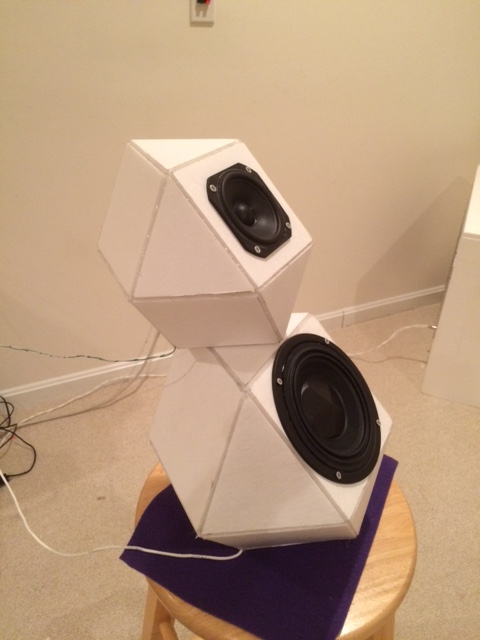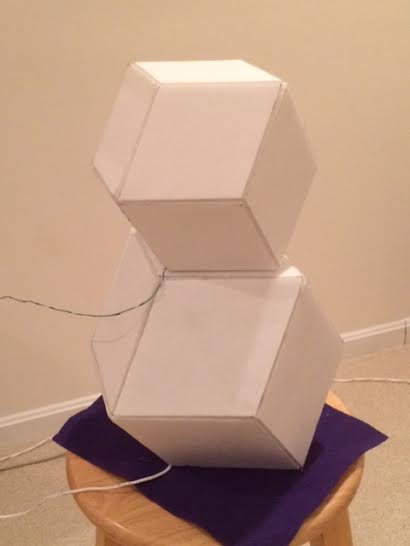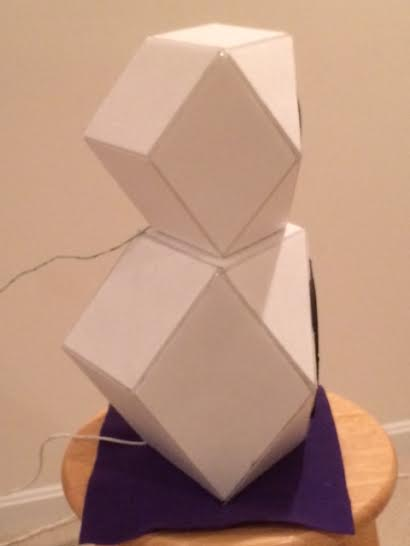There is a neat rhombic dodecahedron enclosure concept being discussed in the Full Range forum: http://www.diyaudio.com/forums/full-range/265053-hypercube-loudspeakers.html So I had the idea of using it in a 2-way rather than as a standalone full range by stacking a small Hypercube on top of a larger one (both sealed) for a two-way speaker. I am using Tang Band W5-876SE for the bass driver and a Vifa TC9FD for the mids/highs in an active setup via miniDSP and TPA3116D2 amps for XO and EQ duties. Here is what it looks like:
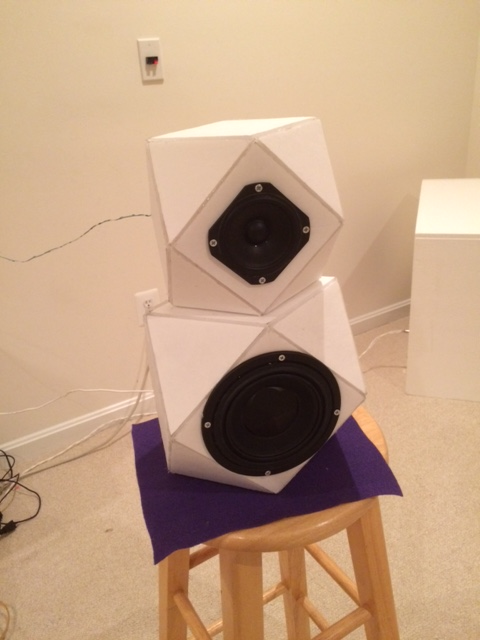
Side view:
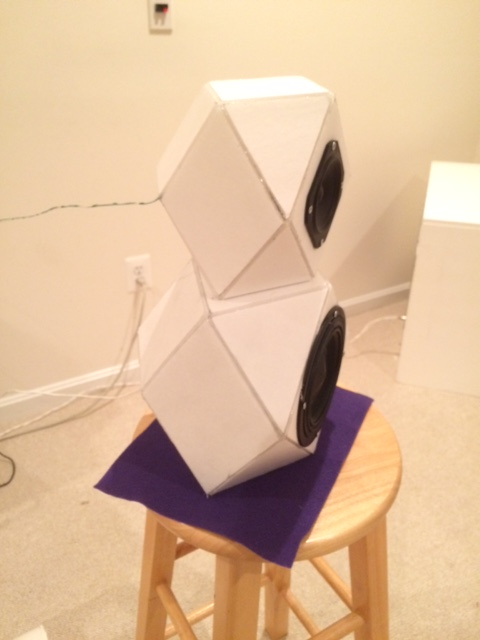
In the miniDSP, I am using a -24dB/oct Butterworth XO at 300Hz, and I boosted the woofer to extend the bass down to 50Hz or so, and put a -5dB baffle step EQ shelf on the TC9FD. Within 30 minutes I had myself a nice FAST Hypercube setup, which I am naming HyperFAST. It was actually very fast to make once you have the housings and a miniDSP active system already. The Tang Band woofer is 87dB and 16ohms which provided a fortuitous match to the less sensitive 8ohm Vifa (85dB) - the levels matched perfectly without any relative gain adjustments. The slight offset of the top provides a natural time alignment. You can see that the phase worked out very flat through the XO region.
Here is the measured XO with and without EQ on the top (purple is before EQ peak cuts, red is woofer, blue is TC9FD, green is combined):
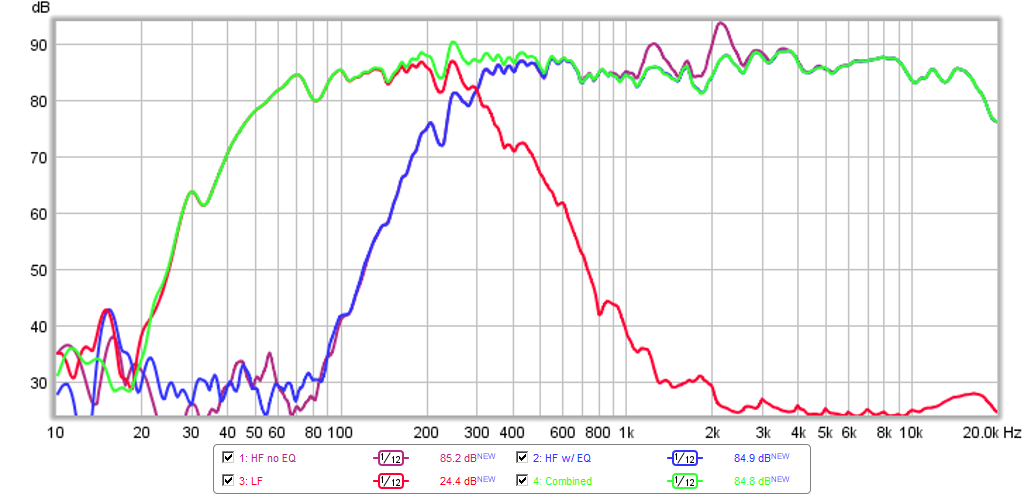
Here is the minimum phase - not bad at all:
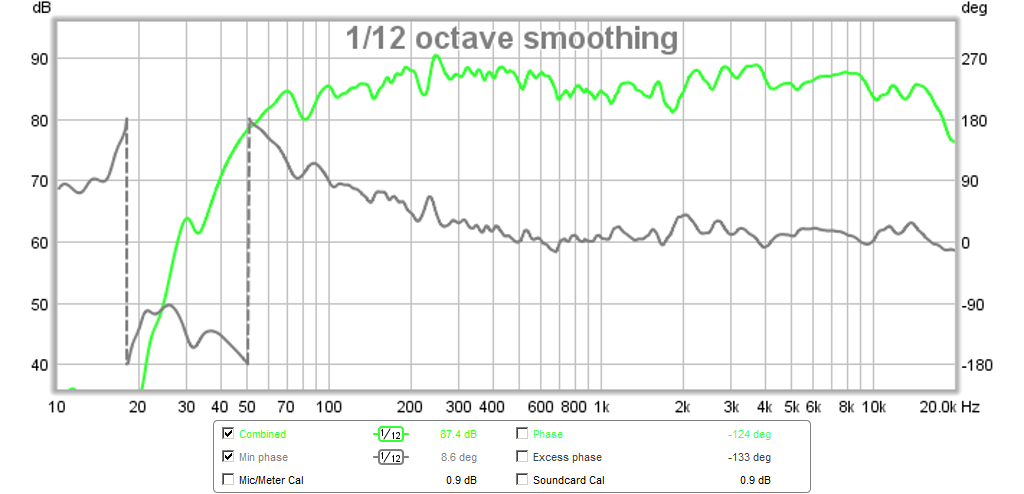
Here is the Impulse response - pretty clean and tight with a mild ringing that can probably be cleaned up with EQ cuts to some of the peaks:
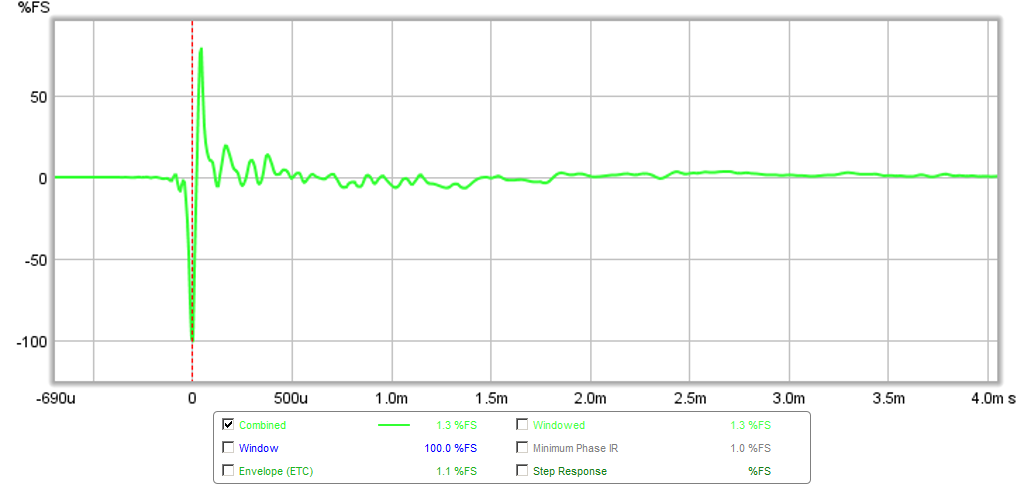
I have not had much of a chance to listen to it, but what I have heard is very nice - great balance and clear clean vocals.

Side view:

In the miniDSP, I am using a -24dB/oct Butterworth XO at 300Hz, and I boosted the woofer to extend the bass down to 50Hz or so, and put a -5dB baffle step EQ shelf on the TC9FD. Within 30 minutes I had myself a nice FAST Hypercube setup, which I am naming HyperFAST. It was actually very fast to make once you have the housings and a miniDSP active system already. The Tang Band woofer is 87dB and 16ohms which provided a fortuitous match to the less sensitive 8ohm Vifa (85dB) - the levels matched perfectly without any relative gain adjustments. The slight offset of the top provides a natural time alignment. You can see that the phase worked out very flat through the XO region.
Here is the measured XO with and without EQ on the top (purple is before EQ peak cuts, red is woofer, blue is TC9FD, green is combined):

Here is the minimum phase - not bad at all:

Here is the Impulse response - pretty clean and tight with a mild ringing that can probably be cleaned up with EQ cuts to some of the peaks:

I have not had much of a chance to listen to it, but what I have heard is very nice - great balance and clear clean vocals.
Attachments
Last edited:
This is incredible. I come back from a hiatus of diyaudio and you guys have figured out a way to make an omnidirectional enclosure, then experiment with 2 ways with advanced DSP's?!
Gah, this blows my mind. So i guess i should ask, how does it sound compared to a traditional sealed speaker?
Great measurements, pictures, and speaker construction btw!
Gah, this blows my mind. So i guess i should ask, how does it sound compared to a traditional sealed speaker?
Great measurements, pictures, and speaker construction btw!
xrk,
In looking at the back of the hypercube when it is angled up, I can see how the shape and flow of the back of the enclosure could improve how the wave travels off the face and around the enclosure, perhaps having a positive effect on diffraction.
In looking at the back of the hypercube when it is angled up, I can see how the shape and flow of the back of the enclosure could improve how the wave travels off the face and around the enclosure, perhaps having a positive effect on diffraction.
how does it sound compared to a traditional sealed speaker?
It sounds very nice compared to traditional 2-way box speaker. I would say there is more of an open sound, more ambiance. Have a listen...
Here is a sound clip (mono speaker only) recorded with a Zoom H4.
Attachments
Byrtt has generously offered to provide me some Dayton RS100-4's to try out in these speakers. Hopefully they can allow the XO point to go down lower because of a lower fs. Will give them a try when they come in. Thanks Byrtt!
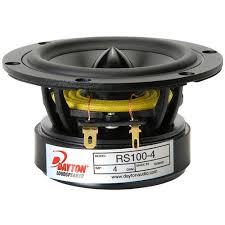
http://www.parts-express.com/pedocs/specs/295-378-dayton-audio-rs100-4-spec-sheet-revised.pdf
Looks like a very nice driver...
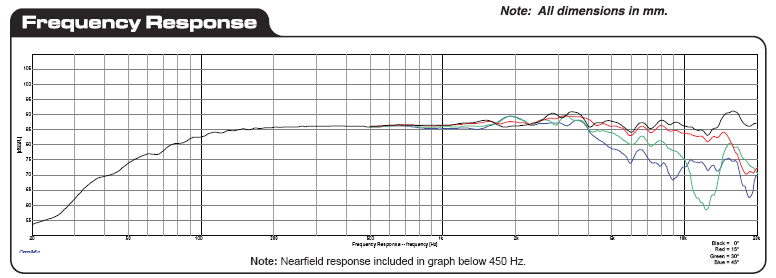
http://www.parts-express.com/pedocs/specs/295-378-dayton-audio-rs100-4-spec-sheet-revised.pdf
Looks like a very nice driver...

Attachments
Last edited:
Xrk:
hiw would you describe the so7nd from the TB W5? When EQ to extend it to 50Hz? No excursion limit at RMS power? No distorsion at higher volumes?
Just asking cause Im looking for some decent 4-5 inch woofer that could go to 50-60Hz in a 2.5L box.
Danny
hiw would you describe the so7nd from the TB W5? When EQ to extend it to 50Hz? No excursion limit at RMS power? No distorsion at higher volumes?
Just asking cause Im looking for some decent 4-5 inch woofer that could go to 50-60Hz in a 2.5L box.
Danny
Xrk:
hiw would you describe the so7nd from the TB W5? When EQ to extend it to 50Hz? No excursion limit at RMS power? No distorsion at higher volumes?
Just asking cause Im looking for some decent 4-5 inch woofer that could go to 50-60Hz in a 2.5L box.
Danny
The TB W5-876SE when used qnty 4 in parallel (4 ohms total load) can be very low distortion and sound excellent. Here it is used in a bass horn with 2.83v drive. As you can see, these are very low levels of HD for the SPL levels produced. This was going through a simple line level passive XO (low pass filter) at circa 150Hz.
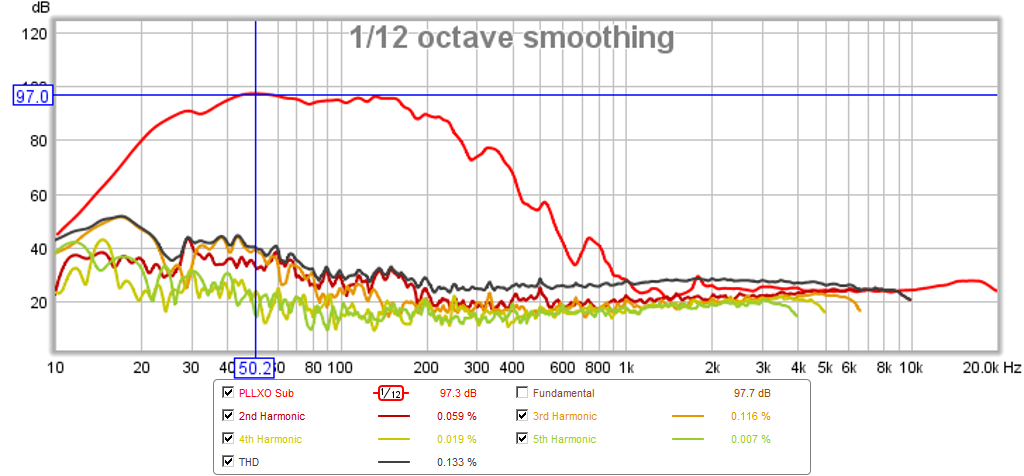
As a single driver in a sealed alignment with EQ boost (essentially a Linkwitz transform) to reach 60Hz, there is considerably more cone movement (2-3mm to reach 90dB at 60Hz) and more harmonic distortion approaching 8% at 50Hz. But for lower to mid 80dB listening levels, the levels of distortion are probably 2% to5% and are not a big deal. I think that much of it may be the foam core walls. I think wood walls on the bass Hypercube should be used here.
Attachments
Last edited:
Thanks.Im not very big into huge SPL levels.Mainly considering drivers for a FAST pc speakers with KEF uni-q drivers. Till this point I have 3 selected.
Danny
Danny
RS100-4 pair status now enroute
Welcome they deserved and very easy confirmed surfing around this domain thanks too...........Will give them a try when they come in. Thanks Byrtt!..........
Those RS100's will come in handy for many kinds of alignments since they have a moderate Qts. MLTL, BLH, DCR, Nautaloss, etc. they look well made too looking forward to playing with them. Thanks again Byrtt. 😀
This will be my first aluminum cone driver and first one with a phase plug. The magnet looks like it is about same diameter as the driver cutout hole.
Gmad, did you apply EQ like Linkwitz transform to extend the bass in a sealed cabinet? Because a sealed box sim predicts no lower than 150Hz before bass starts falling off.
Gmad, did you apply EQ like Linkwitz transform to extend the bass in a sealed cabinet? Because a sealed box sim predicts no lower than 150Hz before bass starts falling off.
My sim in "Winspeakerz" in sealed box gives nearly exactly same F3 as TC9FD. RS100 better in real world practically sized box volume, example set both to Qtc 0,756 where TC9FD need unpractical 20 liters RS100 need 1,4 liter. Combine RS100 more realistic reachable box size the better Xmax 4,0mm verse TC9FD 1,5mm is what make me think RS100 can go lower by same box size, add if the application/room do not demand the drivers max SPL we have some headroom where some EQ could exploit the last Xmax. Think gmad went for 0,7 alignment (~2liter) in Hupercube, this alignment is unreachable by TC9FD because drivers own Qtc 0,72 but even setting it on 0,73 it needs ~73 liter. If xrk971 current Hypercube box is ~3 liter here a attached sim the two drivers in same box, RS100 4,0mm Xmax misses in plot 🙂) difficult to extract the right volume from the discussion xrk971 and Tesserax had this subject over at thread http://www.diyaudio.com/forums/full-range/265053-hypercube-loudspeakers-13.html#post4128860). Hope not did mistakes.
Edit: In plot at F3 and F10 there's dotted line good at pointing out the drivers lowend compared same box size.
Edit: In plot at F3 and F10 there's dotted line good at pointing out the drivers lowend compared same box size.
Attachments
Last edited:
My sim in "Winspeakerz" in sealed box gives nearly exactly same F3 as TC9FD. RS100 better in real world practically sized box volume, example set both to Qtc 0,756 where TC9FD need unpractical 20 liters RS100 need 1,4 liter. Combine RS100 more realistic reachable box size the better Xmax 4,0mm verse TC9FD 1,5mm is what make me think RS100 can go lower by same box size, add if the application/room do not demand the drivers max SPL we have some headroom where some EQ could exploit the last Xmax. Think gmad went for 0,7 alignment (~2liter) in Hupercube, this alignment is unreachable by TC9FD because drivers own Qtc 0,72 but even setting it on 0,73 it needs ~73 liter. If xrk971 current Hypercube box is ~3 liter here a attached sim the two drivers in same box, RS100 4,0mm Xmax misses in plot 🙂) difficult to extract the right volume from the discussion xrk971 and Tesserax had this subject over at thread http://www.diyaudio.com/forums/full-range/265053-hypercube-loudspeakers-13.html#post4128860). Hope not did mistakes.
Edit: In plot at F3 and F10 there's dotted line good at pointing out the drivers lowend compared same box size.
Thanks for the calcs Byrtt. Is the curve with overshoot the TC9FD? The xmax on TC9FD is 2.7mm but I agree that 4mm is way better - similar to the xmax on the CHR70 and A7, and RS100r may be good competition for those drivers with the benefit of a nice alloy frame that doesn't crack easily. The Qts is similar too.
Regarding the volume: it is something I have to come to grips with that Tesserax's geometrically based approach must be correct (11/6 a^3) where a is the length of the square baffle edge or V=1.833*a^3. For the Hypercube I made with a=4.62in (11.73cm)=2960cm^3 or 3 liters.
I have gone through my trigonometrically-based derivation and still cannot find fault with it, other than it doesn't match the geometric derivation of 1 cube + 5/6 of a cube or 11/6 of a cube in volume.
Last edited:
Yes TC9FD is the overshoot plot which maybe graphical fine for bafflestep correction running as fullranger, but when doing FAST maybe better bafflestep corrected with same amount minimum phase EQ to both LF and HF drivers to give them same phase but maybe I'm wrong I'm little unsure what really happens at phase when electrical and acoustic domains are summed, to better understanding the phase domain think would be nice be close family to Tom Danley 🙂).Thanks for the calcs Byrtt. Is the curve with overshoot the TC9FD? The xmax on TC9FD is 2.7mm but I agree that 4mm is way better - similar to the xmax on the CHR70 and A7, and RS100r may be good competition for those drivers with the benefit of a nice alloy frame that doesn't crack easily. The Qts is similar too.
Regarding the volume: it is something I have to come to grips with that Tesserax's geometrically based approach must be correct (11/6 a^3) where a is the length of the square baffle edge or V=1.833*a^3. For the Hypercube I made with a=4.62in (11.73cm)=2960cm^3 or 3 liters.
I have gone through my trigonometrically-based derivation and still cannot find fault with it, other than it doesn't match the geometric derivation of 1 cube + 5/6 of a cube or 11/6 of a cube in volume.
"Crack easily" ups we better wash our mouths.
Great if actual volume is 3 liter then the plot show what happen if you exchange TC9FD by RS100.
EDIT: The present data TC9FD i have says linear Xmax 1,5mm Xpeak 3,0mm, have to investigate.
Last edited:
- Status
- Not open for further replies.
- Home
- Loudspeakers
- Full Range
- HyperFAST - a Hypercube Based 2-Way





